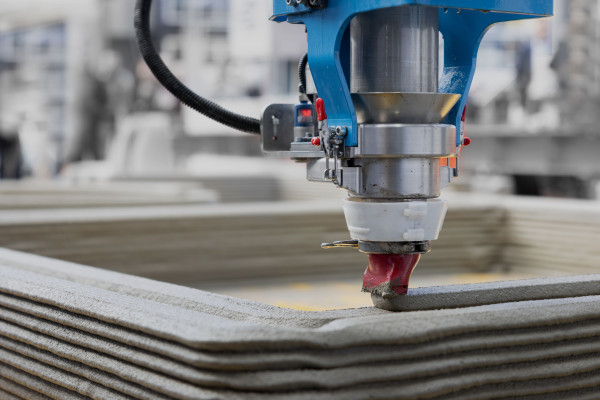-
-
2.2.Virtual Tours
-
2.3.Smart Appliances
-
2.4.Smart Lighting
-
2.5.3D Concrete Printing
-
2.6.Metal 3D Printing
Top Tech Trends that will change Architecture in 2024
What drives us to talk about architectural tech? ensun aims to speed up global business progress. Our web crawlers gather data, and our text-based algorithms organize it systematically. By combining our internal data with external sources, we offer insights into the latest technologies and spotlight the top innovators behind them.
For this report, we've analyzed over 5,194+ relevant companies within the architectural tech sector.
The Technological University Dublin defines architectural technology as “technical design and expertise used in the application and integration of construction technologies in the building design process.”
With this in mind, let’s dive into a few of the latest technologies in architecture.
Latest Architectural Technologies and Their Top Innovators
Because the definition of technologies in architecture is now established, what exactly are those innovations? This section goes beyond typical buzzwords like Cloud Computing or AI. Instead, we will try to introduce you to other relevant industry-driven topics, that are gaining traffic, but are not too prevalent in the public eye. All while giving credit to the top innovators in their field.
So, let's take a closer look at very promising technological trends.
Building Information Modelling
Building Information Modeling (BIM) is a software approach revolutionizing the construction industry by facilitating collaborative planning, designing, constructing, and managing of building and infrastructure projects. Through intelligent 3D models, BIM enhances communication, coordination, and decision-making among project stakeholders, leading to improved efficiency, reduced errors, and cost savings. For instance, BIM enables accurate project visualization and streamlined construction coordination, ultimately resulting in smoother project execution and better outcomes.
Top Innovators
- Nevaris provides a unified software solution for managing construction processes, including tendering and accounting, tailored for the DACH region's elevated construction segment.
- Peri is a supplier of formwork, scaffolding, and engineering solutions to the construction industry.
- United BIM is a certified SBE/MBE firm, offering BIM modeling and coordination services for the construction industry, ensuring efficient construction processes.
Virtual Tours
A virtual tour, as part of 3D mapping, provides an immersive experience of a location through videos, images, or 360-degree views with multimedia elements. Virtual tours let users explore destinations digitally using VR, audio, video, and narration. Despite their benefits in tracking viewer behavior and boosting conversions, virtual tours may lack personal interaction and require resources. However, they offer diverse experiences, allowing for a good alternative for in-person apartment viewings.
Top Innovators
- FLOORFY is a platform that creates 3D virtual tours, property floor plans, HD photographs, and commercial videos from 360º photos of properties uploaded by users.
- Scene3D pioneers 3D scanning and virtual tours, ensuring excellence and timely delivery. Founded in 2018.
- Canadian Virtual Tours creates high-quality 3D virtual tours for businesses, venues, and hotels across Canada, delivering exceptional results with straightforward pricing and professional service.
Smart Appliances
Smart appliances, including ovens with precision cooking algorithms and refrigerators equipped with inventory tracking, are revolutionizing home kitchens. These appliances leverage internet connectivity and remote control capabilities to streamline cooking and cleaning tasks. For example, studies suggest they can reduce cooking time by an impressive 20%, making meal preparation faster and more efficient. Therefore, smart appliances, though not inherently architectural, can profoundly influence architectural design through their integration into smart home systems. But despite their convenience, smart appliances may face disruptions due to reliance on internet connectivity, yet the efficiency gains they offer outweigh this, promising to enhance the kitchen experience.
Top Innovators
- VersaWare pioneers smart kitchen appliances with personalized nutrition AI, making cooking healthier and easier for users seeking dietary improvements.
- Signature Kitchen Suite pioneers smart appliances with cutting-edge technology and precision performance, merging culinary passion with innovation.
- Smarter leads in smart kitchen appliances, offering stylish and efficient solutions like the iKettle and FridgeCam to simplify daily tasks and minimize waste.
Smart Lighting
Smart lights are equipped with internal chips enabling wireless communication with other devices. Through connectivity with apps, smart home assistants, or other accessories, users can automate lighting, adjust colors, and control lights remotely. Typically, Wi-Fi-enabled, these lights connect to the internet via wireless networks. Some variants need a dedicated smart hub for wireless connection. The hub connects to the internet router and serves as a mediator between the smart light and user devices like phones or tablets.
Top Innovators
- MEGAMAN LIGHTING is a global brand providing energy-efficient lighting solutions, including innovative technologies like Dual Beam Technology and Radar Motion Sensor Lights, to enhance quality of life sustainably.
- Nanoleaf revolutionizes smart homes with innovative IoT solutions, blending design and technology for personalized experiences.
- Ecolor Lighting Technology produces smart LED lights for different spaces, including ambient lights and colorful string lights.
3D Concrete Printing
3D printing utilizes computer-aided design (CAD) to fabricate objects layer by layer, commonly employed in manufacturing and automotive industries for crafting tools and parts. In construction 3D printing, key materials like 3D printable concrete are specially formulated, typically comprising cement, aggregates (like sand and gravel), water, and additives.
However, this method can be inefficient, leading to the waste of concrete material and time. It also demands a substantial amount of water and requires constant management of concrete's plasticity as it flows through the extruder and piping, necessitating strict control over water and temperature levels.
Top Innovators
- Click Print Home is a leading design-build firm in Florida, specializing in permitted 3D printed concrete buildings.
- PRINT4D is a pioneering engineering group focused on revolutionizing construction through cutting-edge technology. They specialize in sustainable construction materials and advanced digital tools.
- MAI International GmbH specializes in plaster and grouting technology, offering innovative equipment for construction, tunneling, and mining applications globally for over 50 years.
Metal 3D Printing
Metal 3D printing, also known as selective laser melting (SLM), combines the design flexibility of 3D printing with the mechanical properties of high-performance metal alloys to produce strong, lightweight parts for complex applications. This technique employs electron beams, lasers, or heat to melt and fuse metal, with common processes including Selective Laser Sintering (SLS), SLM, and Direct Metal Printing (DMP) or Direct Metal Laser Sintering (DMLS).
Materials commonly used in metal 3D printing include tool steels, stainless steel, titanium, and aluminum. However, the cost of metals for 3D printing is often higher compared to other forms of the same metal due to special processing and purity requirements. Additionally, some metal 3D printers necessitate inert gas, further adding to the overall annual cost.
Top Innovators
- Metal Tech offer turn-key metal 3D printers, CNC integration, and robotic solutions for different needs.
- Rapid DMLS specializes in Metal Additive Manufacturing for prototyping and production. We offer expertise in 3D Metal Printing, Multiaxis CNC Machining, and reverse Engineering, ensuring quality and efficiency.
- MT 3D focuses on customer satisfaction, bridging the gap between metal 3D printing potential and engineering expertise. We offer high-quality services and support whenever needed.
Forecasted Developments for Transportation Technology
The architecture service industry is expected to experience a significant boom, with projections indicating an impressive $88.61 billion growth by 2027. A major factor propelling this rise is Building Information Modeling (BIM). This cutting-edge technology utilizes digital twins, which are digital representations of buildings, to enable powerful analyses.
Think of being able to run simulations before construction even begins. BIM makes this possible, optimizing the efficiency and lifespan of buildings from the very start. Facility managers also benefit by using BIM to maximize space usage and create efficient maintenance schedules.
But BIM's advantages extend beyond core design functionalities. It acts as a safeguard for building code compliance, minimizing rework, and functions like a digital watchdog, detecting clashes before construction starts, preventing delays and saving resources. BIM even offers a unique advantage: immersive VR presentations that foster stronger client engagement and smoother design processes. While its influence might be subtle, BIM silently shapes the buildings we inhabit by providing comprehensive data to prevent issues and streamline construction for architecture service providers and countless other companies.
Navigating Technological Evolution
In summary, the architectural industry in 2024 is undergoing significant transformations driven by advancements in technology. From Building Information Modeling (BIM) to smart furniture and 3D concrete printing, these developments promise to reshape design processes and improve user experiences. Embracing these trends will not only lead to more efficient and sustainable practices but also foster growth and development within the architectural sector. But more fields than just architectural technology are evolving. Our B2B search engine unveils you suppliers for the exact technology you are looking for – globally and inter-industrial.
Find your right supplier here now.
FAQ about Architectural Tech
Technology has transformed architecture through advanced design and visualization tools like CAD software. Architects can now create complex structures with precision and detail, revolutionizing the design process.
Repurposing shipping containers into living spaces offers a sustainable and innovative approach to creating unique, modular homes.
Tall buildings, whether skyscrapers or high-rises, represent more than just modern urban structures. They serve as tangible symbols of a city's social, economic, political, and even religious influence, reflecting the impact of globalization.
In architecture, the concept of "local in global" and "global in local" is understood as integrating local elements into a global context, or expressing the essence of global influences within a local framework.
MEGA Architecture facilitates the organization and integration of IT system maps into a centralized repository. This enables users to comprehend the connections and interrelationships among applications, and to synchronize IT systems with corporate strategies and business requirements.
Quickscout
Auf der Suche nach
passenden Technolgie-Anbietern?
Beginne jetzt mit dem Scouting!





